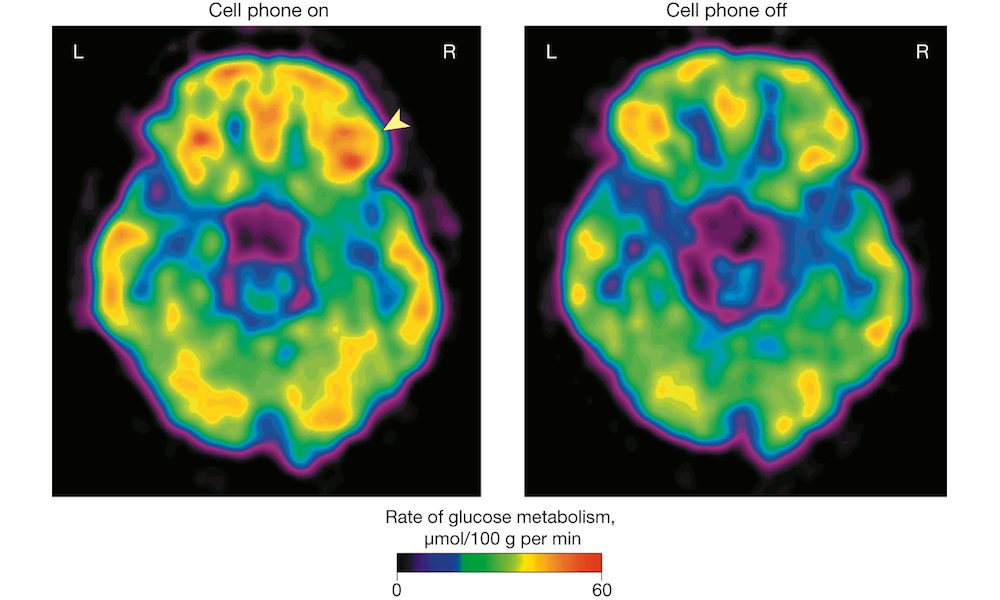3 (Potential) Health Risks of Mobile Phone Usage

Increased brain glucose metabolism after mobile phone usage via the American Medical Association
Toggle Dark Mode
It’s important to realize that regardless of their advanced features like touchscreen displays, powerful mobile operating systems and advanced camera technologies, every mobile phone is built around the same core functionality.
Principally, they can place telephone calls over wireless network signals relying on varying amounts of radio frequency energy to help relay those messages.
Radio Frequency and Radiation
According to the National Institute of Health (NIH), the radio frequency energy emitted by mobile phones is a form of non-ionizing electromagnetic radiation.
While radiation is synonymous with everything from microwave ovens to powerful medical equipment like X-Ray machines, we should at least heed the warnings that our mobile phones emit radiation, too.
We’ve known this for a long time now — although multiple studies examining the real, short- and long-term implications of radiation exposure are currently ongoing.
Still, it should be known that the amount of radio frequency energy users are exposed to ultimately depends on several factors, including their phone’s underlying network technology, the distance between the phone and user during usage, and the amount of usage (length of time/day), among other things.
Health Risks Associated with Mobile Phone Usage
1 Cancer/Tumors
Frequencies emitted by an X-Ray machine are categorized as a form of ionizing radiation, or high-frequency electromagnetic radiation — whereas the frequency emitted by mobile phones is considered non-ionizing low-frequency radiation.
According to NIH, ionizing radiation has been found to increase the risk of developing certain forms of cancer. And while the effects of non-ionizing radiation on the human body are still being investigated on multiple fronts by agencies like the World Health Organization (WHO) and the National Cancer Institute (NCI), it can be said based on empirical findings thus far that non-ionizing radiation can also be “absorbed by tissues” within the general area where a mobile phone is used.
The International Agency for Research on Cancer (IARC), meanwhile, has categorized radiation emitted by mobile phones as “possibly carcinogenic” — meaning there “could be some risk” of cancer or tumor causing properties present — although additional studies are currently ongoing to assess the extent of their prevalence and effect, too.
2 ‘Brain Activation’
A study published in the American Medical Association’s JAMA journal sought to examine the broader effects of non-ionizing radiation from mobile phones on brain function, concluding that “in healthy participants, 50-minute cell phone exposure was associated with increased brain glucose metabolism in the region closest to the antenna.”
Unfortunately, the medical implications of that discovery are currently unknown — but they’re the subject of multiple ongoing studies which hope to ultimately draw a link between brain glucose metabolism and the development of certain irregularities in brain function.
For instance, NIH noted, some studies have reported “adverse health effects” on brain function as the result of using mobile phones, including “changes in brain activity, reaction times, sleep patterns, and cognitive functioning” — although additional studies are likewise needed to validate those findings on an empirically significant scale.
Back in December 2017, meanwhile, the California Department of Public Health issued a lengthy warning to mobile phone users, cautioning them against keeping their mobile phones close to their bodies. The Golden State’s recommendations cite a number of ongoing studies which suggest (but are still inconclusive) that there may be a link between electromagnetic radiation and the formation of tumors, cancer, or other brain abnormalities.
3 Traffic Accidents
One of the more prominent, potentially adverse effects of using mobile phones interestingly hasn’t much to do with radiation, but the increased risk of causing and/or being the victim of traffic accidents as the result of being distracted by the device.
It’s obvious looking at some of the recent news about “smartphone addiction” that some people may have a problem putting their phones down even when seated behind the steering wheel of a moving car.
Unfortunately, the risks of talking or texting while driving can be potentially fatal, as a DailyMail report noted.
Not only are over a quarter (26 percent) of traffic accidents caused by drivers who were either texting or using their phone at the time of collision, but according to the National Safety Council’s statistics, that number (including the estimated 52 percent of instances which resulted in fatality) could actually be underreported for a number of reasons because it’s not feasible to factor in every single traffic accident and the root cause of it.
According to NIH, however, research has shown a 300-400 percent increase in the risk of potentially fatal traffic accidents when mobile phones are determined to be implicated.
Conclusions
These findings are published in a wide range of respectable medical journals and are based on statistics gathered by some of the nation’s (and world’s) leading health and safety agencies.
Still, given the wide range of potential implications, and how much more research is still needed to draw a statistically significant conclusion between them, we wouldn’t advocate losing too much sleep over the idea that talking on our phones is somehow damaging or killing us slowly.. Just try to remember avoiding your phone while driving, and sooner or later definitive science is bound to nudge us in the right direction.






